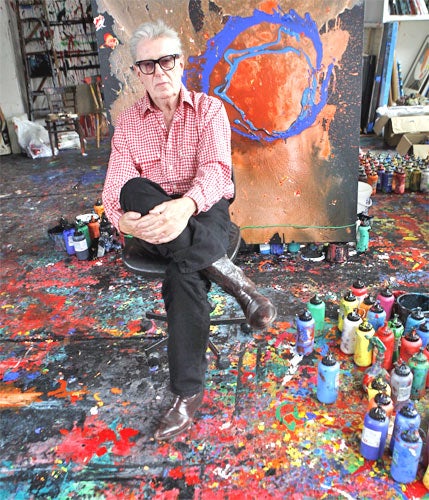John Hoyland: Artist whose vibrant, vivid style made him one of Britain's greatest abstractionists

John Hoyland was one of the great British exponents of abstract painting. His work, much of it on a large scale, is remarkable for its bold useof colour and, in recent years, its three-dimensional quality, through the use of thickly-layered and textured acrylic paint.
He was born in Sheffield in 1934 and studied at Sheffield School of Art during 1951-1956 and the Royal Academy from 1956 to 1960. Classes with William Turnbull at the Central School of Art and a visit to the Tate's "New American Painting" (1959) exhibition were important influences on Hoyland and led him to produce a group of exclusively abstract works for his 1960 diploma show. These were ordered to be removed from the walls by the then RA president, Sir Charles Wheeler, a conservative traditionalist. Fortunately, Hoyland's diploma was nevertheless still granted, based on his earlier, figurative course material.
In 1964 Hoyland had his first solo exhibition, at Marlborough New London Gallery, and took part in a group show at the Whitechapel Gallery, "The New Generation: 1964", alongside David Hockney, Bridget Riley and Patrick Caulfield, with whom he became a good friend. The same year, Bryan Robertson, curator at the Whitechapel, helped Hoyland to gain a bursary for travel to America. Here he met artists of the New York School, including Barnett Newman, Mark Rothko and Robert Motherwell. The critic Andrew Lambirth, author of John Hoyland RA: Scatter the Devils (2009), observes that "Motherwell thought Hoyland could be another Turner, but he preferred to be himself: an endlessly inventive painter who used abstraction to further our understanding and appreciation of the world."
It was the 1967 Whitechapel solo retrospective exhibition, "Paintings 1960–67", that established Hoyland as a force within the world of abstraction. The subsequent five years saw him spending much time in America, working with the artist Peter Stroud, exhibiting at the Robert Elkon gallery and taking up a role as Professor of Fine Art at Colgate University, Hamilton, New York.
By 1973 he was back in the UK, based in London and Wiltshire and soon after started work as a visiting lecturer at St Martin's College and the Slade. A major retrospective was held at the Serpentine Gallery, London, in 1979, bringing together works from the previous 12 years.
Hoyland travelled widely, including visits during the 1990s to the Caribbean, Australia and Bali. Work based on this latter trip was shown at his inaugural exhibition upon joining Theo Waddington Fine Art in 1995. Describing the influence of the Indonesian island, he noted: "There's something almost spiritual about the place and I really like its hybrid culture. It's always summer. And the flora and fauna are fantastic. You get bright red poinsettias as big as oaks supporting parasite flowers of burning orange or the most vivid violet. You should see the sunlight on the banyan trees. Everything's just so rich."
Hoyland's connections with the Royal Academy remained strong since his time there as a student. He was elected an Associate of the Royal Academy in 1983 and to full membership as Royal Academician in 1991. He became Professor of Painting at the RA Schools in 1999 and held an extensive retrospective there in 1999. Beyond his own activity in painting, Hoyland also curated the exhibition "Hans Hofmann, late paintings" (1988) at the Tate Gallery and worked in glass with Murano, Venice in 1994 and 1999.
Throughout his life he showed extensively, including at smaller galleries which might have been off the radar of other artists of his standing. Marie Louise Jones, Director of the Truro-based gallery where he has exhibited three times since 2006, said: "To me John Hoyland was a genius, a contemporary Miro, who showed me great respect and trust when there were clearly other gallerists who were more established. He took a chance on Lemon Street Gallery and for this I will always be truly thankful."
Tate St Ives mounted a retrospective exhibition "John Hoyland: The Trajectory of a Fallen Angel" (2006), curated by Paul Moorhouse. Two years later, the exhibition "Greetings of Love" was inspired by a photograph of blood on a Lebanese hospital floor, published in The Independent alongside an article by Robert Fisk. Fisk pointed out at the time that "... John Hoyland's Blood and Flowers quite scrupulously directs our eyesight on to the bright, glittering centre of gore that we – be we photographers or writers – look at immediately we enter the centre of that little Golgotha which we wish to visit and of which we never wish to be a part: the hospital."
Two monographs have been produced on Hoyland's life and work, by Mel Gooding (1990) and Andrew Lambirth (2009). Lambirth remembers Hoyland as "Generous, hospitable but impatient with the mediocre, John was also very funny. He couldn't resist jokes and would ring up with new stories and mad situations that appealed to his active sense of humour. His wit comes out in his paintings which are brilliantly edgy, confrontational, subtle, dexterous and surprising."
Marcus Williamson
John Hoyland, artist: born Sheffield 12 October 1934; married 1958 Airi Karkkainen (divorced 1968; one son), 2008 Beverley Heath; died 31 July 2011.
Subscribe to Independent Premium to bookmark this article
Want to bookmark your favourite articles and stories to read or reference later? Start your Independent Premium subscription today.

Join our commenting forum
Join thought-provoking conversations, follow other Independent readers and see their replies